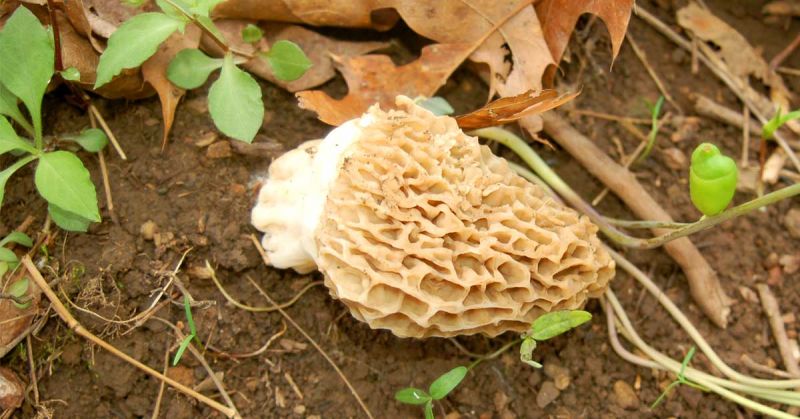Among locavores and foragers, the morel mushroom holds almost cult status adding zest to just about any meat or egg entrée. Eagle Rock’s Dave Garland is one of the many Virginians who regard this fungi as a treasure.

A black morel growing in a yellow poplar stand.
“The black morel is probably the most common variety in our state, and I have found them as early as late March and as late as mid-May,” he said. “Basically, there’s a five-week window, which begins when the soil temperature reaches about 50 degrees and there’s enough moisture to stimulate fruiting.”
Another factor is the presence of certain trees.
“Among the trees, morels seem to grow best around yellow poplars, ashes, elms, and sometimes oaks,” continued Garland. “Perhaps the number one spot would be around a dying elm. Morels seem to undergo this desperation fruiting when this tree starts to die from Dutch elm disease or from some other cause.”
“People who gather morels are really concerned about the emerald ash borer killing off the ashes in Virginia. We’re losing some of our best places to find this mushroom because of the ashes dying.”
Garland adds that morels also often thrive under one shrub in particular – the spicebush which typically form thick copses. Another important point involves correct identification.
Garland urges prospective gatherers venture into the field with someone who is a veteran mushroom enthusiast before attempting to find them on your own. Several lookalike species exist that are dangerous to consume.
Morels, like many edible mushrooms, should not be eaten raw. My wife, Elaine, and I like to saute´ morels in butter and then add them to egg dishes such as omelets and frittatas. Another scrumptious way to enjoy them is to adorn venison or wild turkey burgers with hot, sautéed morels.
For accurate identification, my favorite work is the National Audubon Society’s “Field Guide to Mushrooms”, a very handy book for both experienced and veteran fungi enthusiasts. This guide features 762 color pictures of various species, sections of the various families, and well organized details of a mushroom’s appearance, edibility, season, habitat, and range. For more information: www.audubon.org/national-audubon-society-field-guides.
Garland also suggests joining a group of like-minded individuals. He recommends the New River Valley Mushroom Club.
Concerning where to go, obviously two possibilities are the George Washington and Jefferson National Forest and state wildlife management areas. For the GWJNF, foragers can gather mushrooms for personal use. Commercial gathering requires a permit. On state WMAs, berry picking and gathering of mushrooms and other fruits is allowed for personal use only. Gathering for commercial purposes is prohibited.
Any person 17 years of age or older accessing a DGIF Wildlife Management Area or lake must have in his or her possession one of the following valid Virginia licenses, memberships, or permits: freshwater fishing license, hunting license, trapping license, boat registration, a Restore the Wild membership, or DGIF Access Permit.
— Bruce Ingram, Virginia Department of Game and Inland Fisheries




